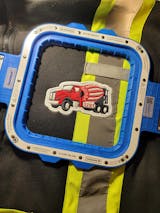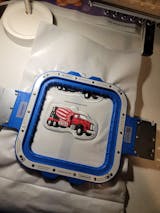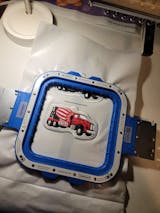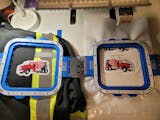1. Introduction to Edge Stitching Fundamentals
Edge stitching is the unsung hero of garment construction and embroidery—where function meets finesse. Whether you’re reinforcing a crisp shirt collar or adding a subtle finish to a couture hem, edge stitching techniques transform raw fabric edges into polished, professional results. These stitches do more than just keep things together; they define the difference between homemade and handmade.
In this guide, we’ll explore the essential edge stitching methods that every sewist should master. From functional reinforcement—like edgestitching and understitching that stabilize seams and prevent rolling—to decorative flourishes such as scalloped or picot edges, you’ll discover how each technique serves a unique purpose. Along the way, we’ll highlight why choosing the right tools, from specialty presser feet to quality thread, can make all the difference in achieving flawless results. Ready to level up your embroidery machine brands edge game? Let’s dive in.
Table of Contents
- 1. Introduction to Edge Stitching Fundamentals
- 2. Core Edge Stitching Techniques: Definitions and Applications
- 3. Decorative vs Functional Edge Finishes Compared
- 4. Edge Stitching Execution: Tools and Machine Techniques
- 5. Comparative Analysis of Related Techniques
- 6. Troubleshooting Common Edge Stitching Challenges
- 7. Conclusion: Choosing the Right Edge Finish
- 8. Edge Stitching FAQ
2. Core Edge Stitching Techniques: Definitions and Applications
Machine embroidery stitches form the family of methods, each with its own role in garment construction. Let's break down the three pillars: edgestitching, topstitching, and understitching.
2.1 Edgestitching: Precision Seam Reinforcement
Edgestitching is the art of sewing a narrow line—typically 1/8 inch (3 mm) from the edge or seam—designed to reinforce and flatten. This subtle stitch is your go-to for keeping collars, waistbands, and facings crisp and secure.
How It Works:
- Stitch Length: Use a regular length (2.5–3 mm) for a smooth, unobtrusive finish.
- Thread: Most often, match your thread to the fabric for a discreet look, though a contrasting thread can add a touch of flair.
Applications:
- Collars and waistbands: Edgestitching keeps seam allowances from shifting and maintains a sharp edge.
- Facings: Prevents facings from peeking out and keeps everything tucked neatly inside.
Technique Tips:
- Align the fabric edge with the inside of your presser foot for consistent distance.
- Press seams before stitching for accuracy.
Why It Matters: Edgestitching is all about subtlety and control. It's visible if you look closely, but it doesn't shout for attention. Think of it as the invisible hand that keeps your garment looking sharp and feeling sturdy.
2.2 Topstitching: Decorative and Functional Accents
Topstitching is the show-off cousin—bold, visible, and often decorative. It's sewn 1/4 inch (6 mm) from the edge or seam and can be both functional and eye-catching.
How It Works:
- Stitch Length: Go longer (3–4.5 mm) to make the stitch stand out.
- Thread: Use a thicker or contrasting thread for maximum impact, especially on denim or outerwear.
Applications:
- Denim and heavy fabrics: Reinforces seams and adds that classic "jeans" look.
- Decorative accents: Highlights pockets, hems, or seams with a pop of color or texture.
Technique Tips:
- Use a topstitching needle for thicker threads.
- Test thread tension and stitch length on a scrap to avoid puckering.
Why It Matters: Topstitching isn't just for looks—it can add strength where you need it most. But it's also your chance to let your creativity shine, turning a functional seam into a design statement.
2.3 Understitching: The Invisible Stabilizer
Understitching is the secret weapon for flawless necklines and armholes. This technique involves sewing 1/8 inch (3 mm) from the seam on the inside of the garment, anchoring seam allowances to facings or linings.
How It Works:
- Visibility: Invisible from the outside—understitching is all about keeping things neat behind the scenes.
Applications:
- Necklines and armholes: Prevents seam allowances from rolling outward, keeping edges crisp.
- Lining attachment: Ensures linings stay hidden and smooth during wear.
Technique Tips:
- Press seam allowances toward the facing before stitching.
- Grade seam allowances (trim one layer shorter) to reduce bulk for a smoother finish.
Why It Matters: Understitching is the difference between a neckline that sits flat and one that insists on flipping out. It's a small step that delivers big results in garment polish.
| Feature | Edgestitching | Topstitching | Understitching |
|---|---|---|---|
| Distance from Edge | 1/8" (3 mm) | 1/4" (6 mm) | 1/8" (3 mm) from seam (inside) |
| Stitch Length | 2.5–3 mm | 3–4.5 mm | 2.5–3 mm |
| Thread Type | Regular/matching | Thicker/contrasting | Regular |
| Primary Purpose | Reinforcement, subtle | Decoration, reinforcement | Prevents seam allowance roll |
| Visibility | Subtle, right side | Prominent, right side | Invisible, right side |
Best Practices:
- Edgestitching: Press seams and use guides for accuracy.
- Topstitching: Lengthen stitches, adjust tension, and use bold thread for effect.
- Understitching: Always grade seam allowances and press before stitching.
Mastering these core edge stitching techniques will elevate your sewing from basic to professional—one crisp seam at a time.
3. Decorative vs Functional Edge Finishes Compared
Edge finishes aren’t just about stopping frays—they’re about making a statement or quietly holding everything together. Let’s explore the spectrum from ornamental to structural, and discover when to blend both for the best of both worlds.
3.1 Ornamental Finishes: Picot, Scalloped and Pinked Edges
Decorative edge finishes are all about visual delight. They add texture, color, and personality—perfect for when you want your seams to be seen.
Popular Techniques:
- Picot Edges:
- Delicate loops, often seen on lingerie or vintage garments.
- Primarily ornamental, offering minimal fraying resistance.
- Best on stable fabrics using proper embroidery hoop sizes—avoid loose weaves.
- Scalloped Edges:
- Curved, wavy outlines created by machine, hand, or specialty scissors.
- May require interfacing for stability; ideal for lightweight fabrics.
- Risk fraying over time—consider reinforcing with additional stitching.
- Pinking Shears:
- Zigzag cuts that slow fraying and add a retro touch.
- Quick and easy, but less durable than serged or bound edges.
- Best for stable fabrics and vintage-inspired looks.
Thread Choices:
Decorative edges often use contrasting colors or specialty threads to stand out, unlike functional finishes that prioritize blend and subtlety.
Limitations:
Ornamental finishes may not withstand heavy wear or frequent washing. Choose them for special occasion garments, light use, or when aesthetics trump durability.
3.2 Structural Solutions: Serging, Binding and Zigzag Finishes
When durability is the goal, functional edge finishes step up to the plate. These methods are engineered to prevent fraying and stabilize raw edges—especially on high-stress or heavy-duty fabrics.
Essential Techniques:
- Serging (Overlocking):
- Uses a serger to enclose raw edges with thread loops.
- Offers maximum fraying resistance; ideal for commercial and heavy-use garments.
- Standard in ready-to-wear clothing.
- Zigzag Stitching:
- Machine zigzag along raw edges to prevent fraying.
- Good for mid-weight fabrics; may distort lightweight materials.
- A practical alternative when a serger isn’t available.
- Bias Bound Seams:
- Encloses edges with bias tape for a clean, tailored finish.
- Strong and fray-resistant—great for unlined jackets or visible seams.
- Adds a touch of color or pattern for subtle flair.
- Flat Felled Seams:
- Encases raw edges within folded fabric, common in jeans and workwear.
- Extremely durable; best for high-stress areas.
- Time-intensive but worth it for longevity.
Fabric Weight Recommendations:
| Fabric Type | Stabilizer Choice | Why It Works |
|---|---|---|
| Knits | Cut-away + adhesive spray | Prevents stretch distortion |
| Silk | Water-soluble film | Dissolves without residue |
| Leather | Tear-away + masking fabric | Cushions without sticking |
3.3 Hybrid Techniques for Dual-Purpose Edges
Sometimes, you want the best of both worlds—a finish that’s as strong as it is beautiful. Hybrid techniques blend decorative and functional elements for seams that stand up to scrutiny and use.
Notable Methods:
- Hong Kong Finish:
- Uses bias tape to encase seam allowances, delivering a clean, professional look and robust edge protection.
- Perfect for unlined jackets where seams are visible.
- Hemstitching:
- Combines functional hemming with decorative stitching on the garment’s front.
- Adds subtle elegance while reinforcing the edge.
- French Seams:
- Encloses raw edges for durability and a neat appearance—especially on sheer or lightweight fabrics.
When to Combine:
- Use hybrid techniques when you want exposed seams to look as good as they perform—think high-end jackets, heirloom sewing, or garments that need to impress inside and out.
Key Takeaway:
Choosing the right edge finish is a balancing act between aesthetics, durability, fabric type, and project purpose. Don’t be afraid to mix and match—serge before adding decorative trim, or bind seams with a pop of color for both structure and style. The right edge finish transforms your sewing from functional to unforgettable.
4. Edge Stitching Execution: Tools and Machine Techniques
The secret to flawless edge stitching isn’t just skill—it’s knowing your tools and how to use them. Whether you’re aiming for crisp, professional seams or tackling slippery knits and heavy upholstery, the right machine settings, presser feet, and hooping solutions make all the difference. Let’s break down the essentials, from technical tweaks to advanced handling.
4.1 Machine Settings and Presser Feet Guide
Edge stitching success starts with dialing in your machine. The right combination of stitch length, width, and presser foot can turn a basic seam into a showpiece—or a structural powerhouse.
| Stitch Type | Length (mm) | Width (mm) | Primary Use |
|---|---|---|---|
| Straight Stitch | 2.5 | N/A | Clean, visible edgestitching |
| Zigzag | 1.5–2.0 | 3.0–3.5 | Raw edge finishing |
| Double Needle | 3.0 | 4.0 | Decorative ribbon hems |
- Straight Stitch Edgestitching:
- Prep your fabric by pressing seams flat—this is your foundation for accuracy.
- Use a straight stitch (2.5mm for medium fabrics). For heavyweights like denim, switch to a thicker needle.
- Align the fabric edge 1/8 inch from the seam, using the presser foot’s markings or the inside toe as a guide.
- Sew slowly for even, tidy results.
- Zigzag Edge Finishing:
- Set stitch width to 3.0–3.5mm and length to 1.5–2.0mm.
- Use an overlock/overedge foot with a wide hole to accommodate side-to-side movement.
- Center the raw edge under the zigzag, letting the needle swing just off the fabric for a secure wrap.
| Tool | Use Case |
|---|---|
| Satin Stitch Foot | Precise edgestitching along trims and ribbon. |
| Blind Hem Foot | Attaching ribbon or securing hems while edgestitching. |
| Standard Foot | Use edge or needle plate markings for guidance—requires control. |
| Edge Guide Feet | 1/16" guides for tight, straight edgestitching or appliqué. |
| Hump Jumper | Levels the presser foot over thick seams for smooth stitching. |
- Edge Guide Feet are a game-changer for ultra-straight lines, especially on appliqué or tight edges.
- Blind Hem and Satin Stitch Feet help you stitch right up against trims or hems, moving the needle as needed for perfect placement.
- Standard Presser Foot works in a pinch—just keep your eye on the guide lines.
Pro Tip: Test your settings on scrap fabric to fine-tune tension and stitch length, especially when switching between fabric weights or decorative and functional finishes.
Decorative Alternatives:
- For ribbon hems, roll the edge under a ribbon, secure with starch, and use a double needle for a clean, hidden finish.
- Try a deconstructed zigzag (1mm wide, 3mm long) with the needle in the rightmost position for textured, frayed looks.
Handling Corners and Curves:
- With a single needle, stop at the corner with the needle down, pivot, and continue.
- For twin needle work, sew past the corner, then manually secure threads with a crosshatch stitch.
Hand-Sewing Alternatives: Hand-rolling with starch or using blind hem stitches can secure edges when machines aren’t an option—ideal for delicate or heirloom projects.
4.2 Fabric-Specific Hooping Solutions for Stable Stitching
Ever tried edge stitching on a slippery knit or bulky upholstery and ended up with puckers, distortion, or misaligned designs? The right hooping solution can be your best ally.
magnetic hoops: The Game Changer for Challenging Fabrics
Sewtalent’s magnetic embroidery hoops are engineered to maintain even tension across all fabric types—especially where traditional hoops fall short:
- Knits and Slippery Fabrics: The powerful magnetic clamping system adapts to varying thicknesses, holding stretchy or slick materials firmly in place. No more shifting or bunching mid-stitch.
- Even Pressure Distribution: Unlike screw-based hoops that can pinch or leave marks, Sewtalent’s design spreads pressure evenly, dramatically reducing distortion and hoop burn.
- Quick Setup: Snap the hoop in place in seconds—no fiddling with screws or risking fabric misalignment. This is a lifesaver for batch production or time-sensitive projects.
Why It Matters: Consistent tension is the foundation of professional edge stitching. With Sewtalent, you get reliable results on everything from delicate jersey to thick terry towels—without the frustration of constant readjustment.
Bonus: The textured surface and wide contact area of Sewtalent hoops keep even heavy or multi-layered fabrics stable throughout the embroidery process, making them ideal for both beginners and high-volume production environments.
4.3 Advanced Methods: Corners, Curves and Hand Alternatives
Edge stitching isn’t always a straight line. When you hit a corner, curve, or specialty finish, a few advanced tricks will keep your work looking sharp.
Pivoting Corners:
- As you approach a corner, stop with the needle down in the fabric. Lift the presser foot, rotate the fabric to align with the next edge, and lower the foot before continuing. This technique ensures a crisp, continuous line—think shirt collars or bag straps.
Curves and Circular Edges:
- For armholes, necklines, or decorative scallops, stitch slowly and guide the fabric gently, making small adjustments as you go. Use a shorter stitch length on tight curves for smoother results.
Rolled Hems on Sheer Fabrics (from YouTube Insights):
- Mark your hem line with a heat-erasable pen.
- Fold the hem over, press, and stitch close to the fold with the needle moved to the right.
- Trim excess fabric close to the stitching with sharp embroidery scissors or duck-billed scissors.
- Fold and press again, then stitch directly over the previous line for a fine, nearly invisible finish.
- For extra finesse, use a zigzag stitch with increased tension to create a subtle ridge—perfect for chiffon or organza.
Machine vs. Hand-Rolled Hems:
- Machine methods offer speed and uniformity, especially for long seams or production work.
- Hand-rolled hems, secured with fine thread and a blind stitch, provide ultimate control on delicate or high-value fabrics.
Pro Tip: Always press after edge stitching—heat sets the stitches and helps the fabric lay flat, especially after rolling hems or topstitching.
5. Comparative Analysis of Related Techniques
When it comes to edge stitching, the details matter. Understanding the subtle differences between similar techniques will help you choose the right method for your project—and avoid common pitfalls.
5.1 Edgestitching vs Topstitching: Distance and Purpose
Let’s clear up the confusion: edgestitching and topstitching may look similar, but their placement, purpose, and impact on your finished piece are distinct.
| Feature | Topstitching | Edgestitching |
|---|---|---|
| Distance from Edge | 1/4 inch (6 mm) | 1/8 inch (3 mm) |
| Primary Purpose | Decorative reinforcement | Functional edge control |
| Thread Type | Heavy, contrasting thread | Regular, matching thread |
| Stitch Length | Longer (3–4.5 mm) | Standard (2.5 mm) |
| Visibility | Prominent | Subtle |
- Topstitching is your go-to for bold, visible lines—think jeans, jackets, or decorative accents. It’s sewn 1/4 inch from the edge, often with thicker, contrasting thread and a longer stitch length. The result? A seam that pops, both visually and structurally.
- Edgestitching sits just 1/8 inch from the edge, using regular thread to blend in. Its main job is to flatten edges, secure linings, and prevent seam allowances from rolling—function first, subtlety always.
Key Takeaways:
- Distance Matters: The closer the stitch, the more functional and less visible it is.
- Thread Choice: Topstitching stands out; edgestitching blends in.
- Purpose: Use edgestitching for structure, topstitching for style—or combine both for maximum impact.
Pro Tip: Specialized feet like edge guide or satin stitch feet help maintain consistent spacing for both techniques, ensuring professional results every time.
5.2 Understitching vs Staystitching: Stabilization Methods
These two terms are often mixed up, but their roles in garment construction couldn’t be more different.
- Understitching:
- Performed on the inside of a garment, it secures seam allowances to facings or linings.
- Prevents seam allowances from rolling outward, keeping necklines and armholes crisp and flat.
- Invisible from the outside—think of it as your secret weapon for a polished finish.
- Staystitching:
- A temporary line of stitching sewn just inside the seam allowance, usually on curved or bias edges.
- Its sole purpose is to stabilize and prevent stretching during construction, especially on necklines.
- Often replaced by lightweight fusible interfacing, but still invaluable for tricky fabrics.
PatternReview Forum Wisdom:
- Staystitching is your insurance policy against stretched-out necklines—do it before handling or sewing curves.
- Understitching is the final touch that keeps facings and linings tucked in place, invisible but essential.
Quick Reference:
| Technique | Placement | Purpose | Visibility |
|---|---|---|---|
| Understitching | Inside, on facing | Secures seam allowance | Invisible |
| Staystitching | Inside, seam allowance | Prevents stretching | Removed/hidden |
With the right embroidery software and edge finish techniques, you'll achieve professional results that elevate your sewing projects from homemade to haute couture.
6. Troubleshooting Common Edge Stitching Challenges
Even seasoned sewists run into edge stitching headaches—fraying, seam rolling, or those elusive crisp edges on tricky fabrics. Here’s how to tackle the most common issues and keep your projects looking sharp.
6.1 Preventing Fraying and Seam Rolling
Fraying Prevention:
- Whip Stitch for Thick Fabrics:
- Loop thread over the edge to trap fibers—ideal for wool or felt.
- Not suitable for delicate fabrics like chiffon.
- French Seams for Sheers:
- Enclose seam allowances within a folded edge, eliminating fraying.
- Use sharp needles and precise alignment to avoid bulk.
- Rolled Hems for Sheer Fabrics:
- Trim seams closely, fold twice, and sew with a straight stitch for a nearly invisible finish on organza or chiffon.
Seam Rolling Solutions:
- Understitching:
- The unsung hero for preventing facings and linings from flipping out.
- Anchor seam allowances to the facing, keeping edges flat and professional.
- Pressing:
- Press every edge after stitching—heat sets stitches and helps seams lay flat.
- Presser Feet:
- Use a roller foot for thick fabrics or a Teflon foot for slippery materials.
French Seam Recommendations:
Perfect for delicate materials, French seams hide raw edges and preserve drape—just remember to trim seam allowances with duck-billed scissors for a refined finish.
6.2 Crisp Edges on Difficult Fabrics: Solutions and Tools
Techniques for Tricky Fabrics:
- Delicate Fabrics (Chiffon, Silk):
- French seams and rolled hems prevent fraying and keep edges light.
- Use lightweight polyester or silk thread for minimal visibility.
- Knits and Stretch Fabrics:
- Opt for stretch or zigzag stitches to allow movement without breaking.
- Ballpoint or jersey needles prevent runs and skipped stitches.
- Heavy Fabrics (Denim, Wool):
- Reinforce with topstitching and heavy-duty thread.
- Titanium-coated needles handle the toughest materials.
Sewtalent Hoops for Thick Upholstery:
When working with heavy or multi-layered fabrics, Sewtalent magnetic hoops provide a secure, slip-free grip. The even pressure distribution ensures that even thick upholstery fabrics stay put—no slippage, no distortion, just crisp, even edge stitching every time.
Tension Maintenance Benefits:
Stable hooping means less puckering, straighter seams, and fewer needs for embroidery machine repairs near me. Whether you’re sewing a delicate silk scarf or upholstering a chair, maintaining even tension is your ticket to professional results.
Best Practices:
- Match thread weight to fabric: 60–80 wt for delicates, 30–40 wt or topstitch thread for heavies.
- Trim seams with duck-billed scissors for precision.
- Use tape instead of pins on slippery fabrics to avoid distortion.
Final Tip:
Align your stitch type, thread, and tools with your fabric’s quirks. With the right setup—and a little patience—you’ll conquer even the most challenging edge stitching scenarios.
Ready to take your edge stitching from “good enough” to gallery-worthy? With these tools, techniques, and troubleshooting tips, you’re set to tackle any project with confidence—no matter how tricky the fabric or how demanding the finish.
7. Conclusion: Choosing the Right Edge Finish
Selecting the ideal edge finish is a blend of art and strategy—think of it as matching the perfect frame to a masterpiece. The best technique depends on your fabric type, the function of the garment, and your own comfort level with various methods. Lightweight sheers may call for delicate French seams or rolled hems, while heavy denim or upholstery demands robust topstitching or bound edges. Decorative finishes like scalloped or picot edges shine on special-occasion garments, but might not withstand everyday wear.
Ultimately, your choice should balance durability, aesthetics, and practicality. Are you aiming for invisible polish or bold, visible accents? Does your project need to survive countless washes, or is it destined for the runway? Remember, tension consistency is the foundation of every crisp edge—whether you’re sewing by hand or machine, take time to test your settings and stabilize your fabric.
Let your creativity lead, but let the needs of your fabric and project digitizing software for embroidery machines should guide your hand. With the right edge finish, your work won’t just hold together—it’ll stand out.
8. Edge Stitching FAQ
8.1 Q: Can I edge stitch without special presser feet?
A: Absolutely! While specialty feet like edge guides or blind hem feet can make edge stitching more precise, you can achieve clean results with a standard presser foot. Use the inside edge or center line of the foot as your guide, and sew slowly to maintain a consistent distance from the fabric edge. Practice on scraps to build confidence—precision comes with patience and a steady hand.
8.2 Q: How do I prevent wavy stitching on knits?
A: Wavy stitches on knits are a common frustration, but you can outsmart them. First, use a ballpoint or jersey needle to avoid snags. Adjust your machine’s presser foot pressure if possible, and opt for a stretch or zigzag stitch to allow the fabric to move naturally. Stabilize the fabric with lightweight interfacing or a strip of water-soluble stabilizer under the seam. And remember—don’t stretch the fabric as you sew; let the feed dogs do the work.
8.3 Q: What’s the difference between edge stitching and topstitching needles?
A: The distinction lies in the thread and the effect you want. Topstitching needles have a larger eye to accommodate heavier or specialty threads, making them ideal for bold, decorative topstitching. Edge stitching typically uses a standard or universal needle with regular thread, focusing on subtlety and control rather than visibility. Choose your needle based on the thread weight and the look you’re after—subtle reinforcement or standout style.
Ready to put your new edge finishing knowledge into action? Experiment, practice, and don’t be afraid to mix techniques. The perfect edge is just a stitch away!







